AgentOps helps developers see inside their AI agents by logging every prompt, action, and cost. This review explains how it works, its features, setup, and why it’s becoming the go-to debugging tool for AI developers.
The Ultimate Guide to Funnels: Every Type You Need to Know (With Examples)
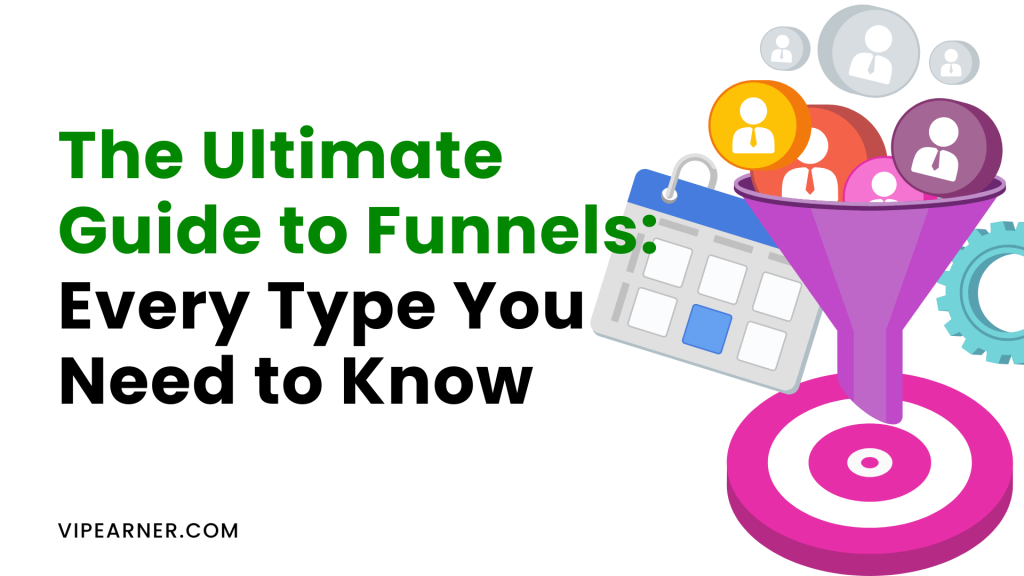
Funnels are one of the most powerful yet misunderstood concepts in online business. Whether you're selling a product, generating leads, or simply guiding users through your website, a funnel is the invisible path that turns strangers into loyal customers — step by step.
Originally used in sales, the funnel concept has now expanded into nearly every area of modern business: marketing, customer onboarding, analytics, e-commerce, apps, and more. If you've ever downloaded a free guide, signed up for a free trial, or made a purchase after watching a video — you were in a funnel, whether you knew it or not.
In this guide, we’ll break down every major type of funnel you need to know — from classic sales funnels to growth loops, app funnels, webinars, email sequences, and even chatbot-powered flows. You'll learn:
- What each funnel does
- Where it's used
- Real-world examples
- The best tools to build them
Whether you’re brand new to funnels or want to level up your strategy, this post will give you a complete overview — with nothing left out.
Let’s dive in.
Core Funnel Types (Across Business Functions)
Funnels are visual frameworks that help businesses understand how people move from being strangers to becoming customers. Think of a funnel as an upside-down triangle — it’s wide at the top where lots of people enter, and narrow at the bottom where only a few people make it all the way through.
Here’s a breakdown of the core funnel types that most businesses use. These are the "big picture" funnels that apply across industries.
1. Sales Funnel

A sales funnel maps the steps a potential customer goes through before buying something. It’s one of the most well-known types of funnels and is often used by sales teams to track how close someone is to making a purchase.
🔹 Example:
Imagine you’re selling online coaching for fitness. Here's what the sales funnel might look like:
- Awareness – Someone sees your ad on Instagram.
- Interest – They click the ad and read your blog about “Top 5 Exercises to Lose Belly Fat.”
- Consideration/Decision – They sign up for a free consultation call.
- Action – They join your coaching program.
🔹 Why it’s useful:
- Helps sales teams know where to focus their efforts.
- Makes it easier to predict revenue based on how many people are in each stage.
2. Marketing Funnel
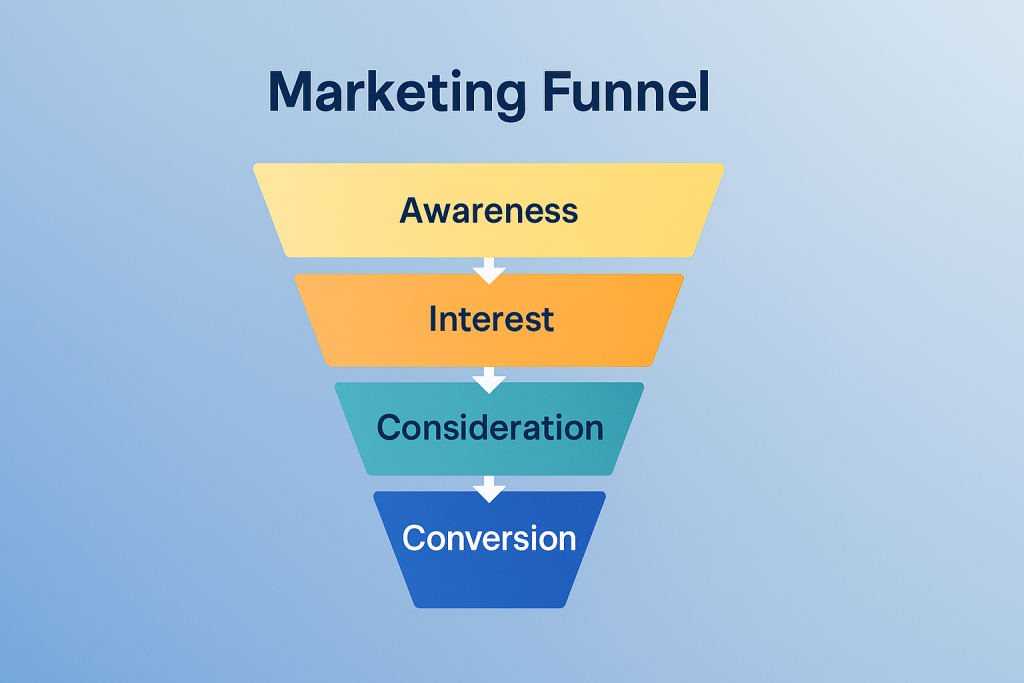
The marketing funnel is like the sales funnel’s best friend — but it’s focused on engaging and educating people before they’re ready to buy. It’s used mostly by marketers to attract attention and build relationships.
🔹 Common Stages:
- Top of Funnel (TOFU): Grab attention (e.g., blog posts, social media, videos).
- Middle of Funnel (MOFU): Build trust (e.g., free guides, webinars, email newsletters).
- Bottom of Funnel (BOFU): Push toward buying (e.g., testimonials, product demos).
🔹 Example:
A software company wants to attract new users.
- TOFU: They publish a blog called “5 Tools Every Remote Worker Needs.”
- MOFU: Readers download a free PDF comparing popular productivity apps.
- BOFU: The company offers a free trial of their own app and sends follow-up emails.
🔹 Why it’s useful:
- Builds a relationship with potential customers over time.
- Helps move people toward a purchase without being pushy.
3. Conversion Funnel
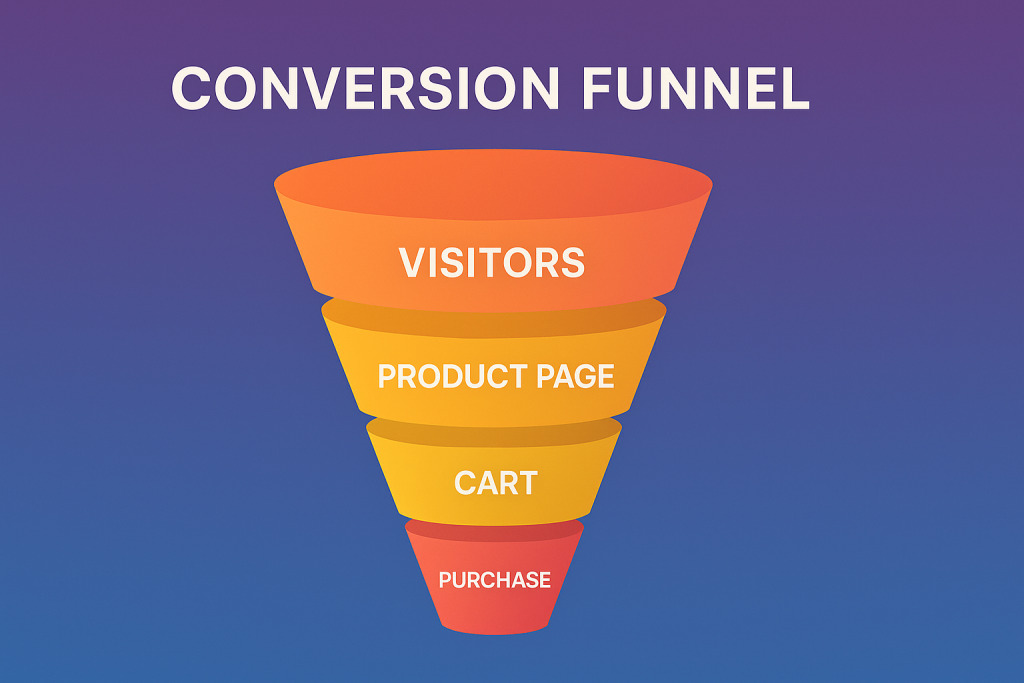
This funnel focuses on how people take specific actions on your website or landing page, like signing up or buying. It’s all about turning visits into results.
🔹 Example:
You’re selling a $29 eBook. Your funnel might look like this:
- Landing Page: Someone clicks your ad and lands on your site.
- Product Page: They read about the eBook and see reviews.
- Add to Cart: They decide they want it.
- Checkout: They enter their payment info.
- Confirmation: They get a thank-you page and receipt.
🔹 Why it’s useful:
- Helps you see where people are dropping off (e.g., they leave during checkout).
- Lets you optimize small steps to increase sales.
4. E-commerce Funnel
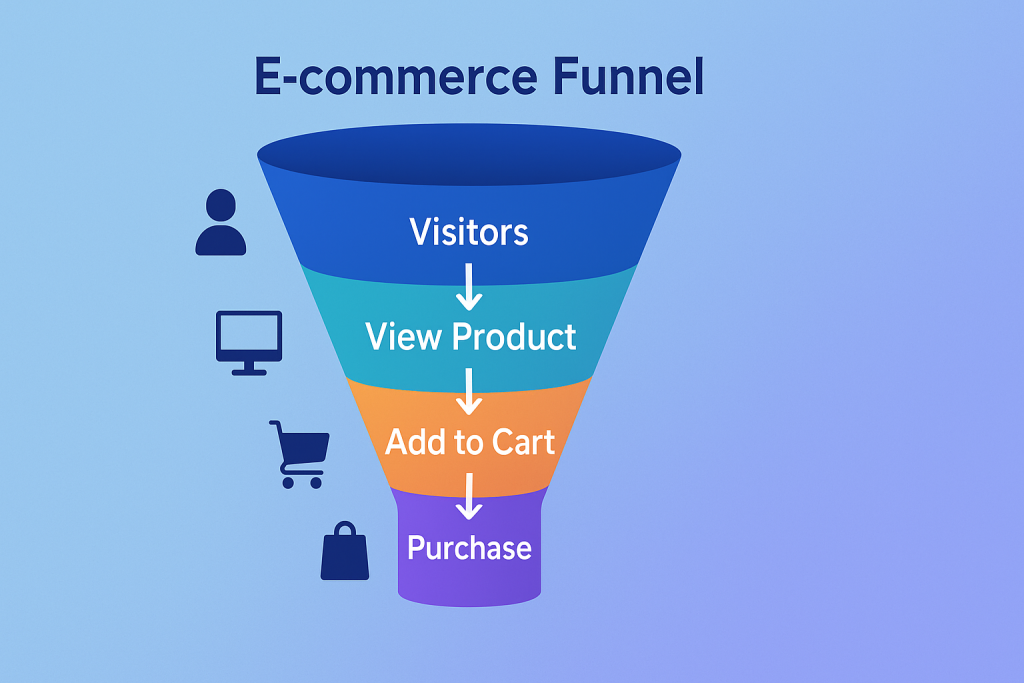
This is a version of the conversion funnel made specifically for online stores. It's designed to guide shoppers from browsing to buying.
🔹 Example:
You run an online store selling phone accessories.
- Product Discovery: A customer finds your store from a Google search.
- Product View: They check out a case for the iPhone.
- Add to Cart: They like it and add it to their cart.
- Begin Checkout: They enter their shipping address.
- Payment: They pay with a credit card.
- Post-Purchase: You email them a discount code for their next order.
🔹 Why it’s useful:
- Helps you design a smoother buying experience.
- Shows you how to recover abandoned carts (e.g., via emails or retargeting ads).
5. Lead Generation Funnel
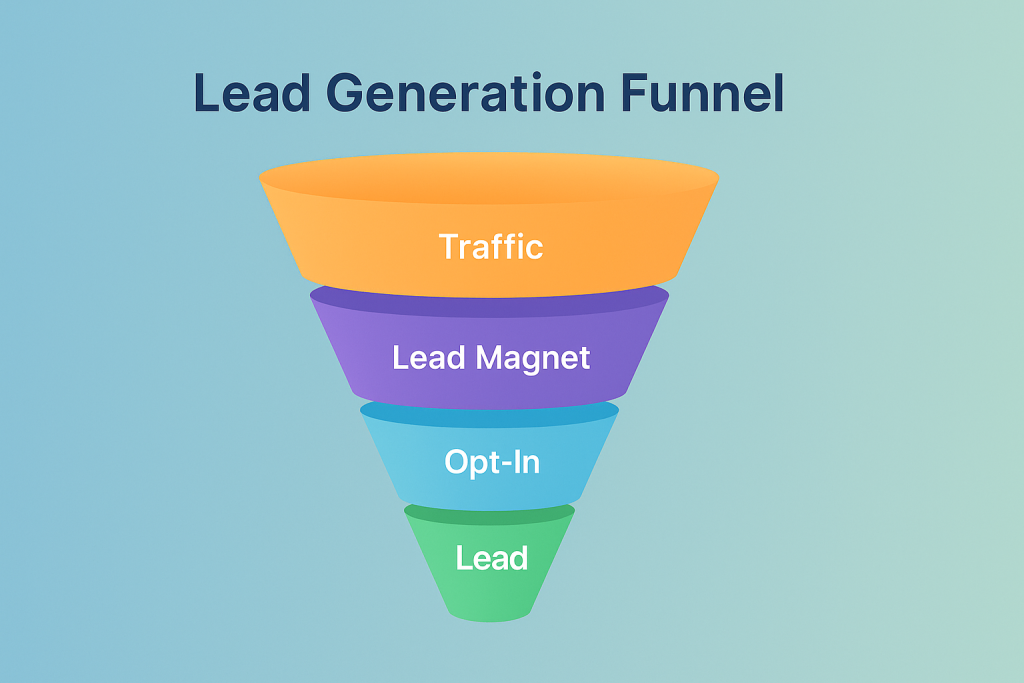
This type of funnel is all about collecting contact info from potential customers — especially useful if you sell services or expensive products and want to follow up with leads later.
🔹 Example:
You’re a wedding photographer looking for clients.
- Attract: Someone finds your Instagram post showcasing your work.
- Offer: You offer a free checklist, “10 Questions to Ask Before Hiring a Photographer.”
- Capture: They enter their email to download the checklist.
- Follow-up: You send them more tips and invite them to schedule a consultation.
- Close: They book you for their wedding.
🔹 Why it’s useful:
- Builds a list of potential customers.
- Warms up leads before they talk to your sales team.
✅ Summary Table
| Funnel Type | Purpose | Best For |
|---|---|---|
| Sales Funnel | Move leads to paying customers | Sales teams, high-ticket offers |
| Marketing Funnel | Build interest and trust | Content & email marketers |
| Conversion Funnel | Optimize website actions | E-commerce, landing pages |
| E-commerce Funnel | Guide online shoppers to purchase | Online stores |
| Lead Gen Funnel | Collect emails or contact info | Consultants, B2B, agencies |
Specialized Funnels (Niche & Strategic Use-Cases)
While core funnels like sales and marketing apply to almost every business, specialized funnels are tailored for specific purposes — like running a webinar, promoting an app, or nurturing users after a sale. These funnels are often shorter, more targeted, and highly effective when done right.
1. Webinar Funnel

A webinar funnel is used to attract leads, get them to sign up for a live (or pre-recorded) event, and then convert them into customers during or after the webinar.
🔹 Example:
You’re a business coach offering a $997 course.
- Registration Page: People sign up for a free webinar, “How to Launch a 6-Figure Coaching Business.”
- Email Sequence: They receive reminders leading up to the webinar.
- Live Webinar: You deliver value and pitch your course at the end.
- Replay Page: You send the recording for those who missed it.
- Follow-up Emails: Limited-time offer with bonuses to encourage sign-ups.
🔹 Why it’s useful:
- Great for high-ticket offers.
- Builds trust and authority in real time.
2. Email Marketing Funnel
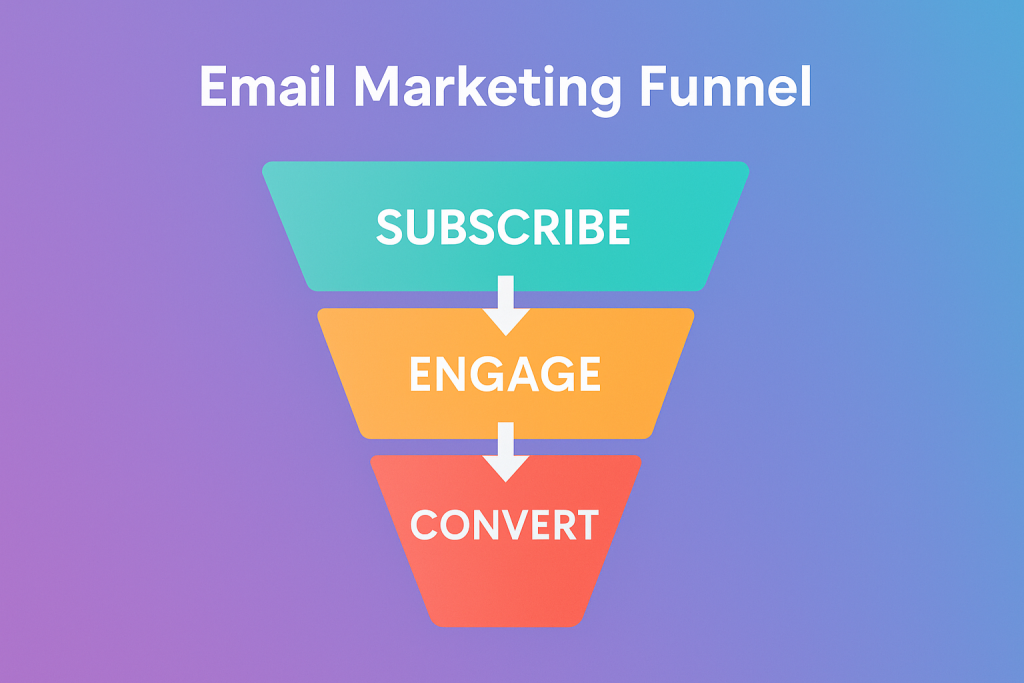
An email marketing funnel is an automated sequence of emails that guides subscribers through a journey — whether that’s buying, booking a call, or staying engaged with your brand.
🔹 Example:
You run a productivity app with a free trial.
- Day 1 – Welcome Email: Intro to the app and what to expect.
- Day 3 – Feature Highlight: Show how to use a key feature.
- Day 5 – Case Study: Share how someone used it to save 10 hours/week.
- Day 7 – Offer: 20% discount to upgrade before the trial ends.
🔹 Why it’s useful:
- Works on autopilot.
- Keeps your brand top-of-mind.
- Builds trust and educates users over time.
3. Product Onboarding Funnel
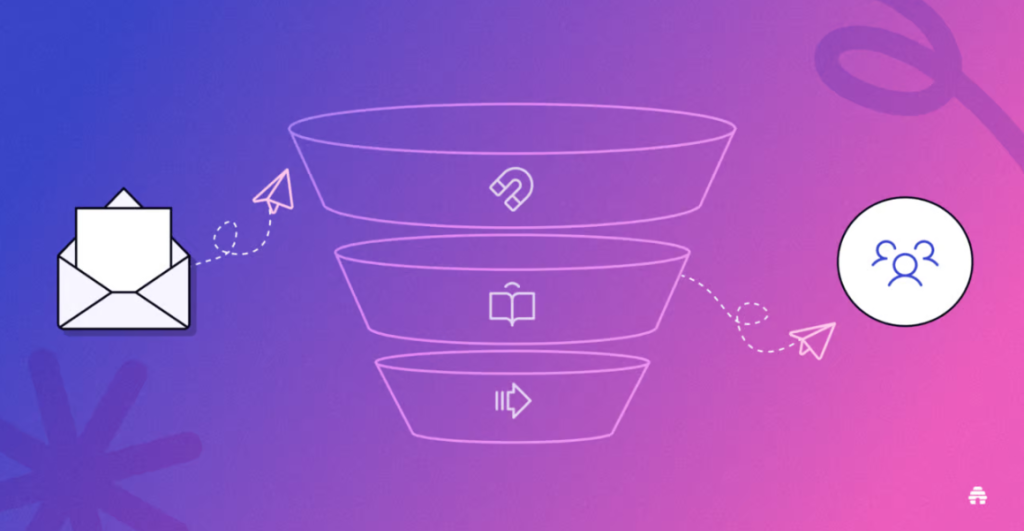
Mostly used in SaaS (Software-as-a-Service) and apps, this funnel is designed to help new users understand and use your product quickly so they don’t churn.
🔹 Example:
You have a task management tool.
- Signup: User creates a free account.
- Tutorial Walkthrough: Guided steps to set up their first project.
- Usage Nudges: Emails or in-app messages encourage usage (“You haven’t added any tasks yet!”).
- Milestone Emails: Celebrate when they complete first task, invite team, etc.
- Upgrade Prompt: Once they’re using it, show benefits of upgrading to Pro.
🔹 Why it’s useful:
- Increases activation and retention.
- Reduces user drop-off after sign-up.
4. Customer Success Funnel
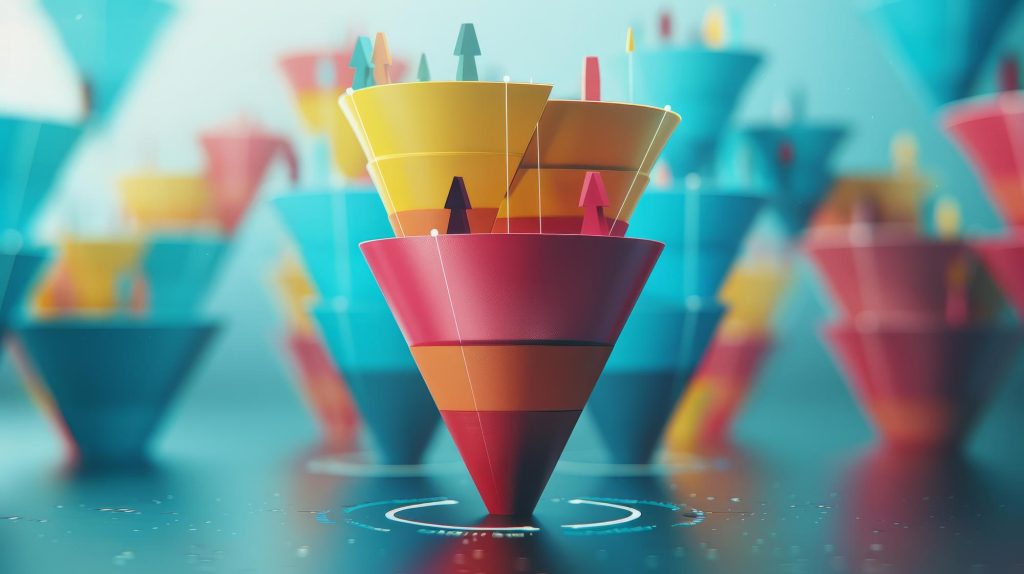
This funnel is used after a sale to make sure customers get value, stay loyal, and even refer others. It’s especially important in businesses with subscriptions or long-term relationships.
🔹 Example:
You sell a monthly subscription box.
- Welcome Kit: Email series explaining what to expect.
- Usage Tips: Videos or blog posts on how to make the most of each box.
- Feedback Request: Ask about their experience after 1–2 months.
- Loyalty Offer: After 3 months, offer a free gift to keep them subscribed.
- Referral Request: Invite them to refer a friend and get a reward.
🔹 Why it’s useful:
- Improves retention and reduces churn.
- Turns customers into advocates and promoters.
5. Affiliate/Referral Funnel
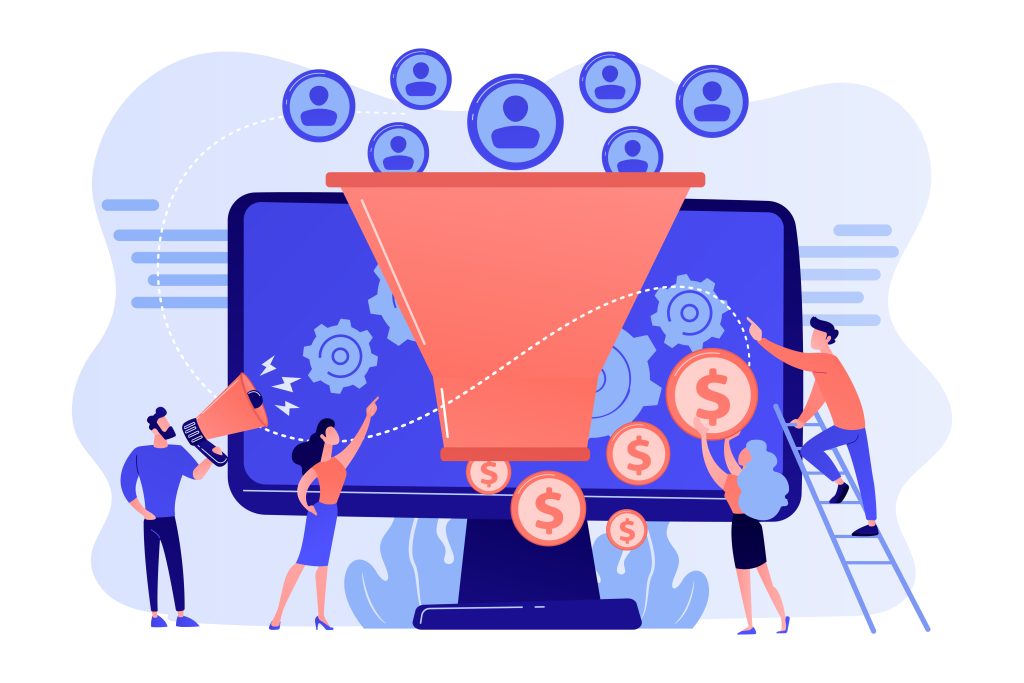
This funnel encourages your happy users to refer others in exchange for rewards, discounts, or commissions.
🔹 Example:
You offer an online course.
- Invitation: Students are invited to become affiliates.
- Training Page: They learn how to promote it.
- Referral Link: They get a custom tracking link.
- Promotion Help: You give them email templates and social media posts.
- Commission: They earn money when someone signs up through their link.
🔹 Why it’s useful:
- Low-cost marketing.
- Leverages word of mouth from people who already trust you.
6. Event Funnel
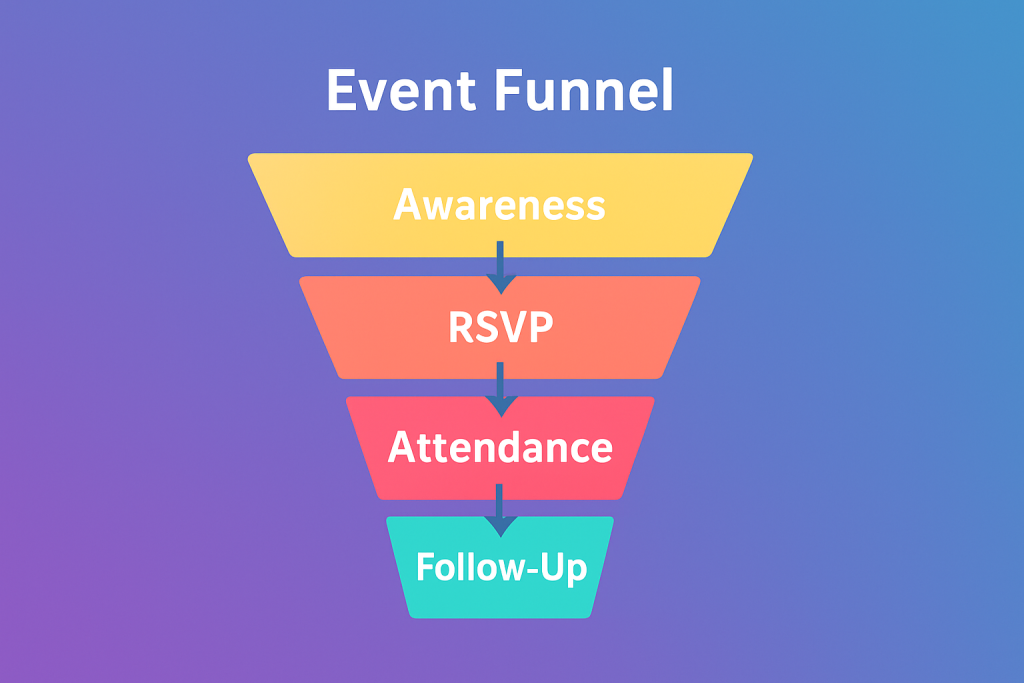
Designed to promote and fill seats at in-person or virtual events (like conferences, summits, meetups).
🔹 Example:
You’re hosting a 2-day business summit.
- Awareness: Facebook and Instagram ads target your niche audience.
- RSVP Page: Visitors land on a page to register (free or paid).
- Email Follow-up: Send info, logistics, and speaker highlights.
- Show-Up Strategy: Reminders, bonus materials, or last-minute offers.
- Post-Event Offer: Sell replay access, a membership, or future event tickets.
🔹 Why it’s useful:
- Ensures high attendance.
- Builds community and post-event engagement.
✅ Summary Table
| Funnel Type | Purpose | Ideal For |
|---|---|---|
| Webinar Funnel | Educate and sell live | Coaches, consultants, course creators |
| Email Funnel | Nurture subscribers automatically | SaaS, eCommerce, digital marketers |
| Onboarding Funnel | Guide users after sign-up | SaaS, mobile apps |
| Customer Success Funnel | Improve retention & loyalty | Subscriptions, B2B, SaaS |
| Affiliate Funnel | Leverage referrals for growth | Digital products, eCommerce |
| Event Funnel | Maximize attendance and follow-up | Events, workshops, summits |
Analytical Funnels
Analytical funnels are used to track how people move through a series of steps on your website or app. Unlike marketing or sales funnels, these are used mainly for measurement and optimization. They show you exactly where users drop off so you can fix problems and improve performance.
1. Analytics Funnel (like Google Analytics or Mixpanel)
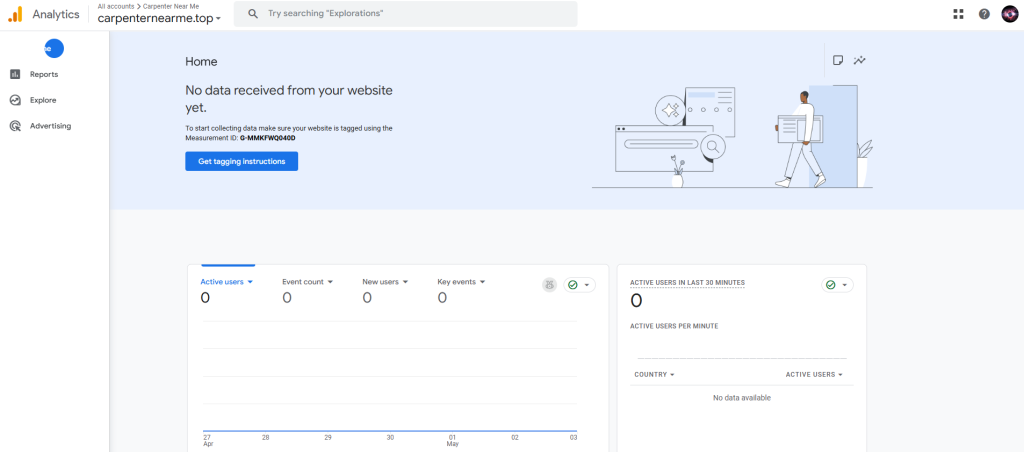
This funnel tracks the exact steps a visitor takes from entering your site to completing a goal (like making a purchase or signing up). You define the steps and tools like Google Analytics or Mixpanel visualize how many people drop off at each one.
Example:
You run a fitness gear website and want to track purchases.
- Step 1: Visits product page
- Step 2: Adds item to cart
- Step 3: Begins checkout
- Step 4: Completes purchase
If you see 5,000 visitors at Step 1 and only 500 purchases at Step 4, your funnel shows the percentage drop-off at each step. This helps you know where you're losing people and what to fix—maybe your checkout page is too slow or confusing.
Why it's useful:
- Helps find bottlenecks in your process
- Easy to test and improve one step at a time
- Data-driven insights for decision-making
2. A/B Testing Funnel
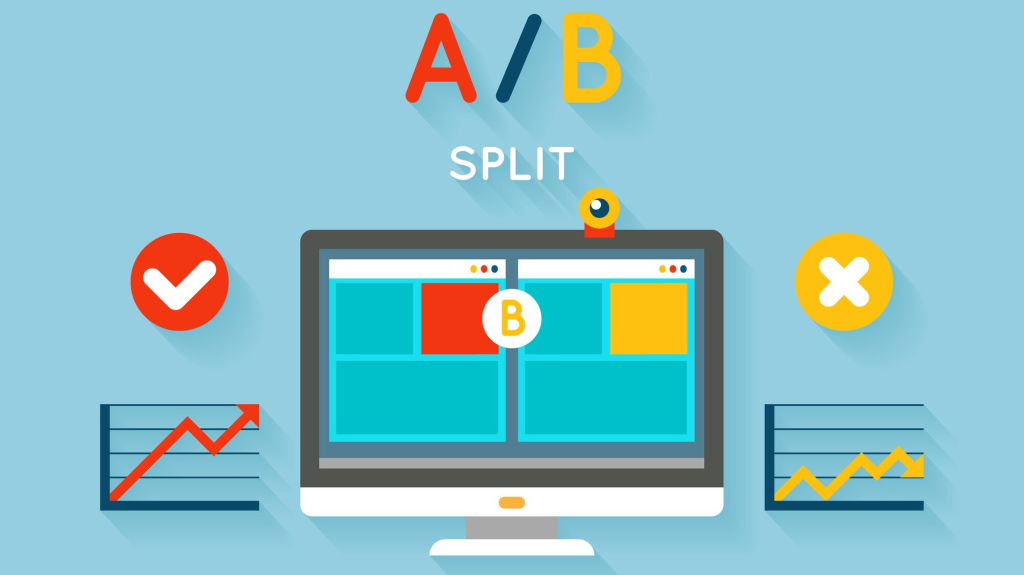
This funnel is used when you want to compare two or more versions of a page or step in your funnel. You test different versions (A and B) to see which one performs better - this could be a different headline, call-to-action button, image, or layout.
Example:
You’re testing two versions of a landing page:
- Version A: “Get Your Free Guide”
- Version B: “Download the Ultimate Fitness Plan”
You set up an A/B test and send 50% of visitors to each. The funnel tracks how many people convert from each version. If Version B gets a 30% signup rate and Version A only gets 15%, you keep Version B and continue optimizing from there.
Why it's useful:
- Takes the guesswork out of design decisions
- Increases conversions over time
- Can be applied to any step in your funnel
These types of funnels are especially helpful for businesses that rely heavily on websites or apps, where even small improvements in conversion rates can make a big difference in revenue.
Platform-Specific Funnels
Not all funnels live on landing pages or websites. In today’s digital world, platforms like mobile apps and software-as-a-service (SaaS) tools require custom funnel strategies to acquire users, activate them, and keep them coming back.
Let’s look at the most important platform-based funnel types.
1. App Funnel (Mobile App Funnels)
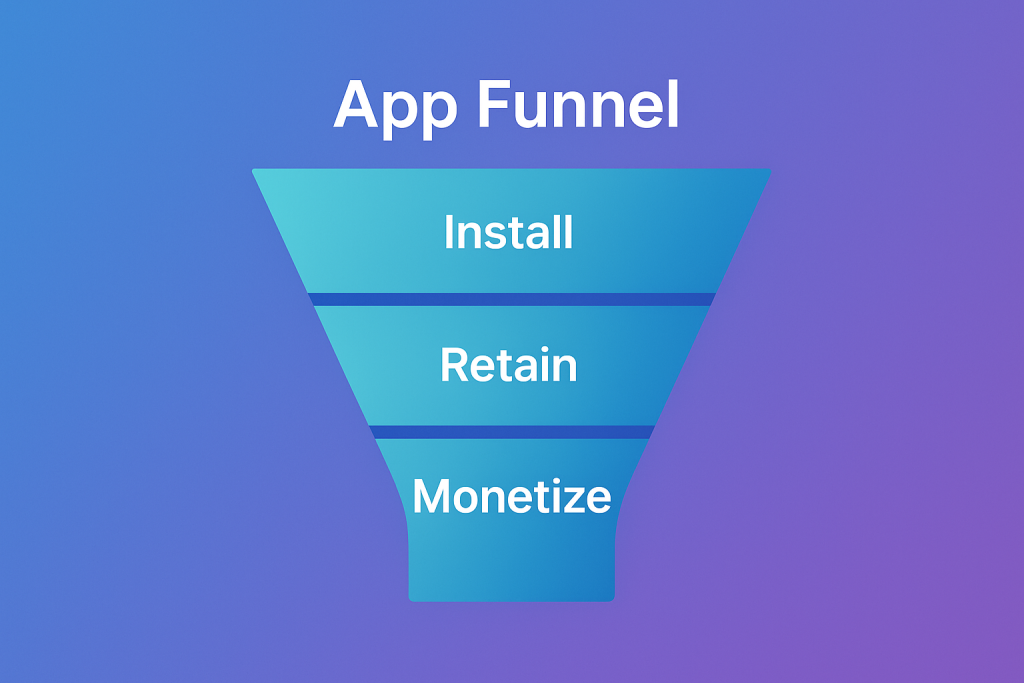
This funnel tracks the user journey from discovering a mobile app to becoming an active, loyal user. It’s critical for app developers and marketers trying to increase installs, reduce uninstalls, and boost retention.
🔹 Example:
You’ve launched a meditation app.
- App Store Visit – User searches for “meditation app” on the App Store or Google Play.
- Install – They download your app.
- First Launch – They open it and see an onboarding tutorial.
- Account Creation – They create an account or link it to Google/Facebook.
- First Session – They complete a meditation.
- Retention – You send reminders to keep them coming back.
🔹 Key Focus Areas:
- App Store Optimization (ASO)
- Onboarding UX
- Push notifications & retention strategies
🔹 Tools:
- Firebase
- Adjust
- Appsflyer
- Mixpanel (for mobile)
2. SaaS Free Trial Funnel
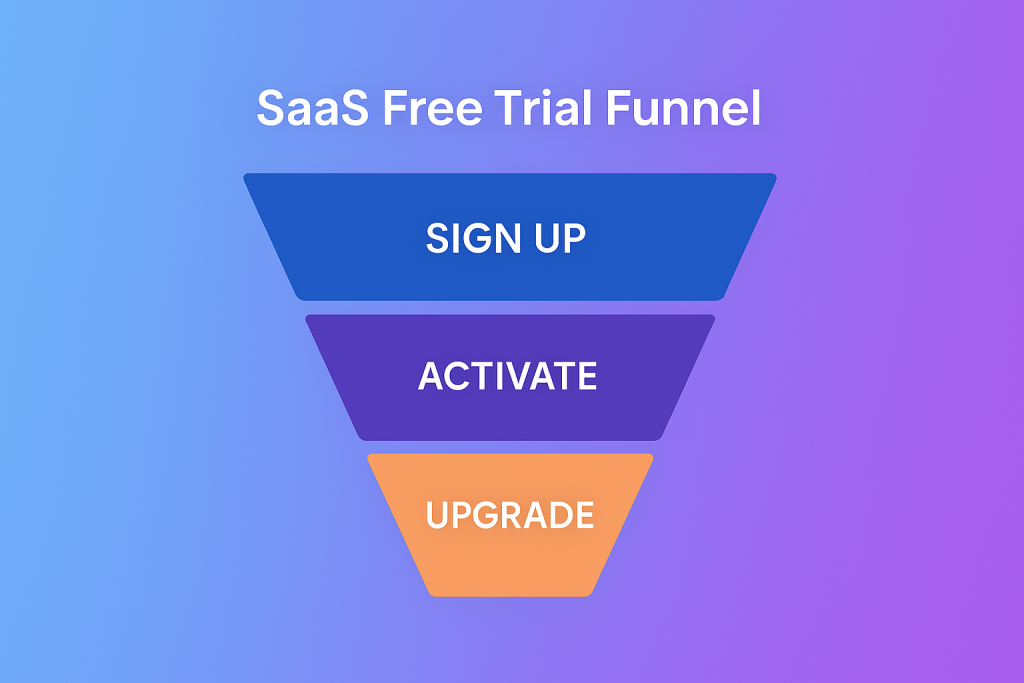
This funnel is common in subscription-based software businesses. It focuses on turning free trial users into paying subscribers by getting them to experience the product’s value quickly.
🔹 Example:
You offer a project management tool with a 14-day trial.
- Signup – User creates an account for the free trial.
- Onboarding – You guide them through setting up their first project.
- Activation – They invite teammates and complete key actions (e.g., create tasks).
- Value Realization – They start using it regularly and see improvements.
- Upgrade Prompt – Before the trial ends, you show benefits of going paid.
🔹 Best Practices:
- Use onboarding checklists or tours
- Trigger emails based on in-app behavior
- Shorten time to first value (TTFV)
🔹 Tools:
- Intercom
- Userpilot
- Pendo
- Stripe (for managing trial > paid conversions)
3. App Store Funnel
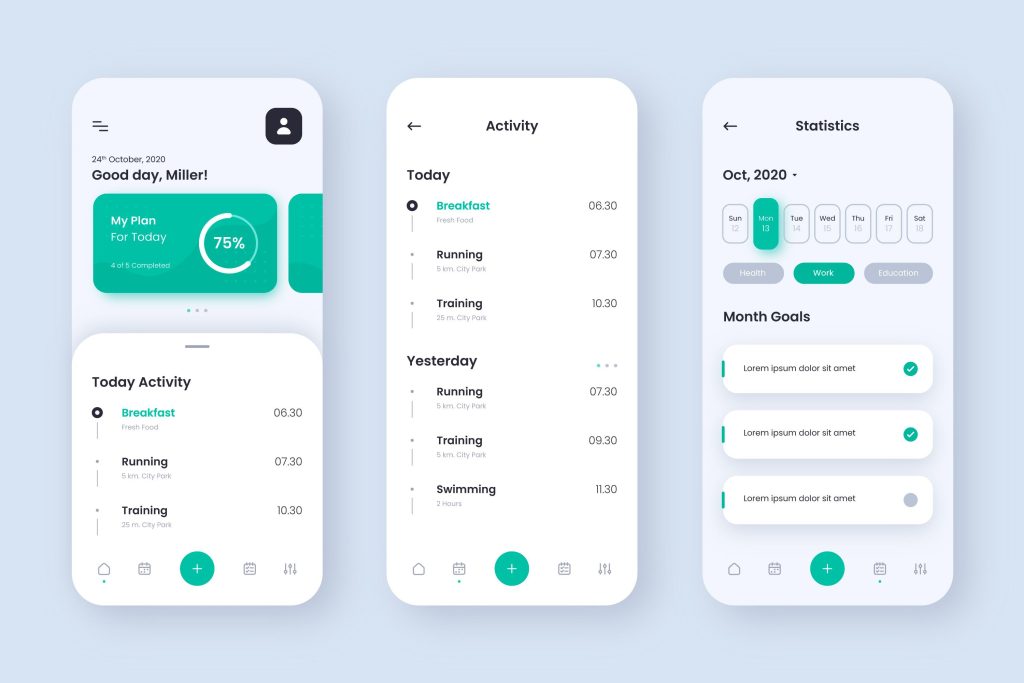
This is a micro-funnel that happens entirely within the app store, but it’s crucial because it determines whether a user will even try your product.
🔹 Example:
You’ve developed a fitness tracking app.
- Discovery – User finds your app via keyword search, ads, or featured listing.
- Impression – They see your app’s name, icon, and rating.
- Click-through – They tap on your app listing.
- Evaluation – They look at your screenshots, reviews, and description.
- Install or Bounce – Based on what they see, they either download or move on.
🔹 Optimization Tips:
- Use compelling icons and clear screenshots
- Highlight key benefits in the first 2 lines of description
- A/B test app store creatives (tools like Storemaven or SplitMetrics)
✅ Summary Table
| Funnel Type | Focus | Best For |
|---|---|---|
| Mobile App Funnel | From install to regular usage | App developers & marketers |
| SaaS Free Trial Funnel | From sign-up to upgrade | Software products (B2B/B2C SaaS) |
| App Store Funnel | Optimize install rate via store presence | Mobile apps on iOS/Android |
These platform-specific funnels are about adapting to user behavior on mobile and SaaS environments — where expectations for speed, clarity, and value are much higher.
Growth Funnels (Startup-Style & Scalable Models)
Growth funnels are designed to fuel rapid, sustainable growth. Unlike traditional sales funnels that end at purchase, growth funnels look at the entire lifecycle of a customer — from acquisition to retention and beyond.
The most well-known framework in this space is AARRR, also known as Pirate Metrics (because of the acronym’s sound).
1. AARRR Funnel (Pirate Metrics)

Created by Dave McClure, AARRR breaks down the 5 critical stages in a startup or digital product’s growth.
Let’s walk through each stage with a practical example:
🔹 Example:
You’ve launched a task management app for freelancers.
A – Acquisition
How do people find you?
- Examples: Google search, Facebook ads, YouTube, referrals
- Tools: Google Analytics, UTM tracking, ad platforms
💡 You track that 5,000 people visited your website this month.
A – Activation
Do they have a great first experience?
- Examples: Signing up, completing onboarding, creating a first task
- Key metric: Time to first value (TTFV)
💡 Out of 5,000 visitors, 1,000 signed up and created their first task.
R – Retention
Do they come back?
- Examples: Logging in again, using the app weekly, continuing their subscription
- You aim to reduce churn here
💡 You notice 700 users are still active after 30 days — a 70% retention rate.
R – Referral
Do they tell others?
- Examples: Sharing your app, inviting teammates, giving reviews
- Strategies: Referral programs, incentives, social sharing tools
💡 100 users invited a friend, and 40 new users signed up from those invites.
R – Revenue
Are they paying you?
- Examples: Subscription upgrades, course purchases, app monetization
- Track: Lifetime value (LTV), average revenue per user (ARPU)
💡 Out of 700 retained users, 150 upgraded to paid — bringing in $3,000 this month.
Why AARRR Works:
- Gives a complete growth overview, not just marketing or sales.
- Helps identify your biggest bottleneck (e.g., poor retention vs. poor acquisition).
- Works well for SaaS, apps, and digital products.
2. Growth Loop Funnels
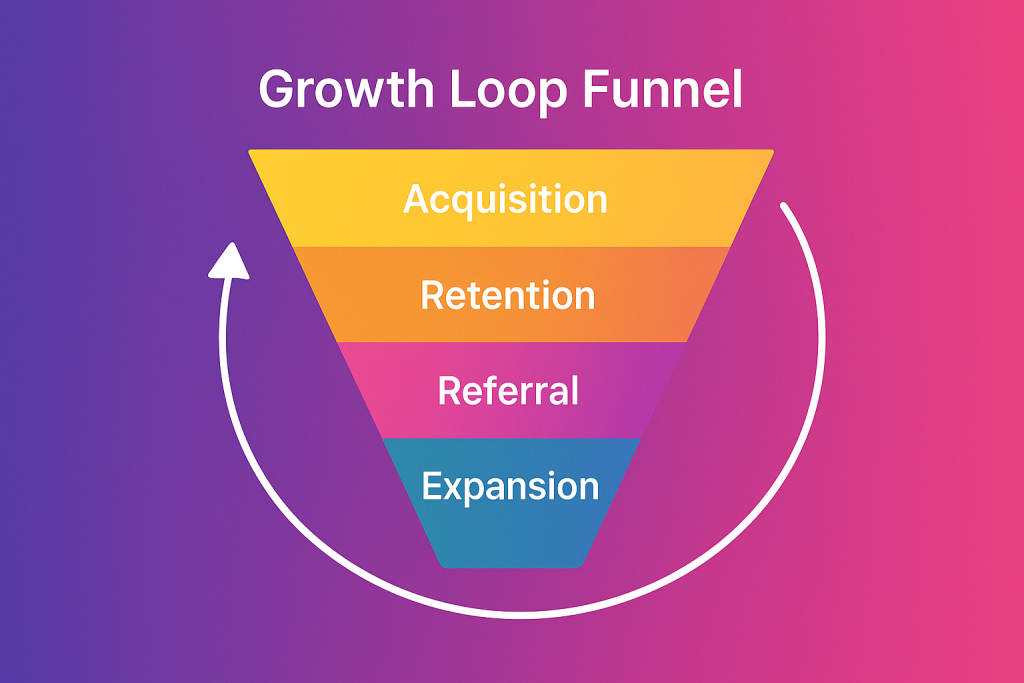
A more modern approach to funnels is thinking in loops instead of straight lines.
🔹 Example:
You create a quiz builder tool. Users sign up, create quizzes, and share them — which brings in more users who repeat the process.
- User creates quiz
- Shares quiz with audience
- New people take the quiz
- New people sign up to make their own quiz
Each user helps generate more users, creating a growth loop.
🔹 Why it’s useful:
- Loops are self-sustaining and compounding.
- Favored by product-led companies (e.g., Dropbox, Notion, Calendly).
✅ Summary Table
| Funnel Model | Focus | Best Used For |
|---|---|---|
| AARRR (Pirate Metrics) | Full customer journey (acquisition → revenue) | SaaS, startups, digital products |
| Growth Loop Funnel | Self-repeating, compounding growth | Freemium tools, viral apps |
Advanced & Modern Funnels
Traditional funnels work, but as audiences evolve, so do the ways we engage and convert them. Advanced funnels use tools like chatbots, quizzes, video, and high-touch applications to personalize the experience and increase conversions.
Let’s break down the most common modern funnel types you should know.
1. Chatbot Funnel
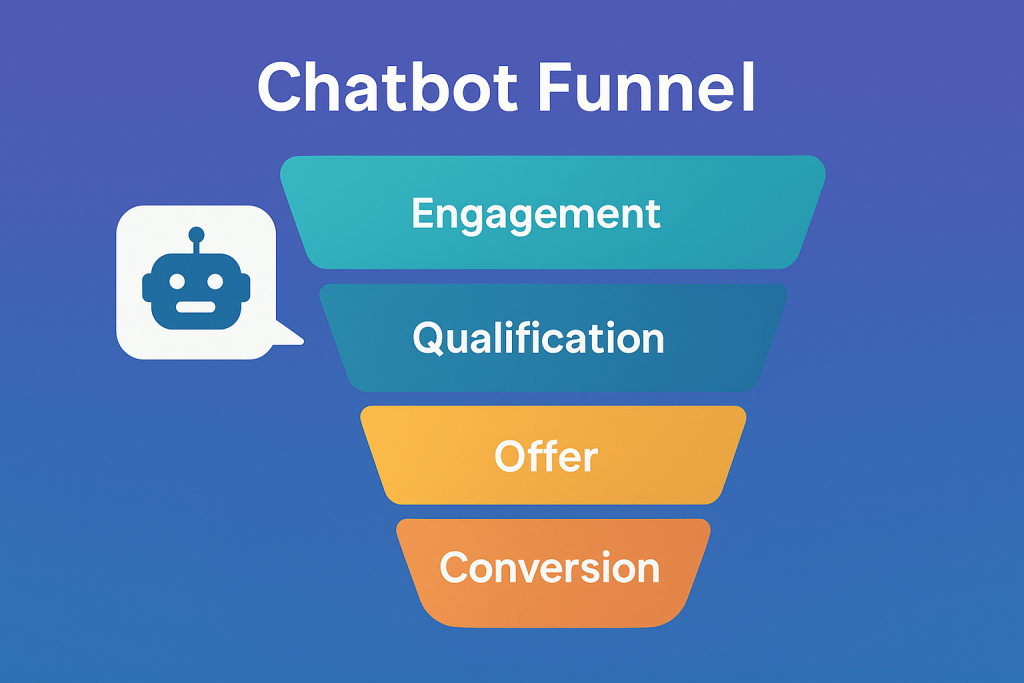
A chatbot funnel uses automated conversations (via Messenger, WhatsApp, or website chat) to guide users through a funnel without needing forms or web pages.
🔹 Example:
You run a digital marketing agency.
- Ad Click – A Facebook ad opens a Messenger conversation instead of a landing page.
- Qualification – The bot asks, “Are you a business owner?” “What’s your monthly ad budget?”
- Lead Capture – The bot collects their email or phone number.
- Appointment Set – They book a call directly in Messenger.
🔹 Why it’s useful:
- Feels personal and fast.
- Increases engagement compared to static forms.
- Great for mobile users.
🔹 Tools:
- ManyChat
- Chatfuel
- MobileMonkey
2. Quiz Funnel
A quiz funnel attracts attention with interactive content and segments leads based on their answers — then makes a personalized offer.
🔹 Example:
You sell skincare products.
- Quiz: “What’s Your Skin Type?”
- Questions: Age, gender, concerns (e.g., acne, dryness), routine.
- Result Page: “You have dry skin. Here’s your perfect routine.”
- Product Recommendation: Personalized bundle + discount.
- Lead Capture: Email required to get results.
🔹 Why it’s useful:
- High engagement and opt-in rates.
- Helps you deliver tailored offers.
- Works well in eCommerce, info products, and coaching.
🔹 Tools:
- Typeform
- Outgrow
- Interact
- LeadQuizzes
3. Video Sales Funnel (VSL Funnel)
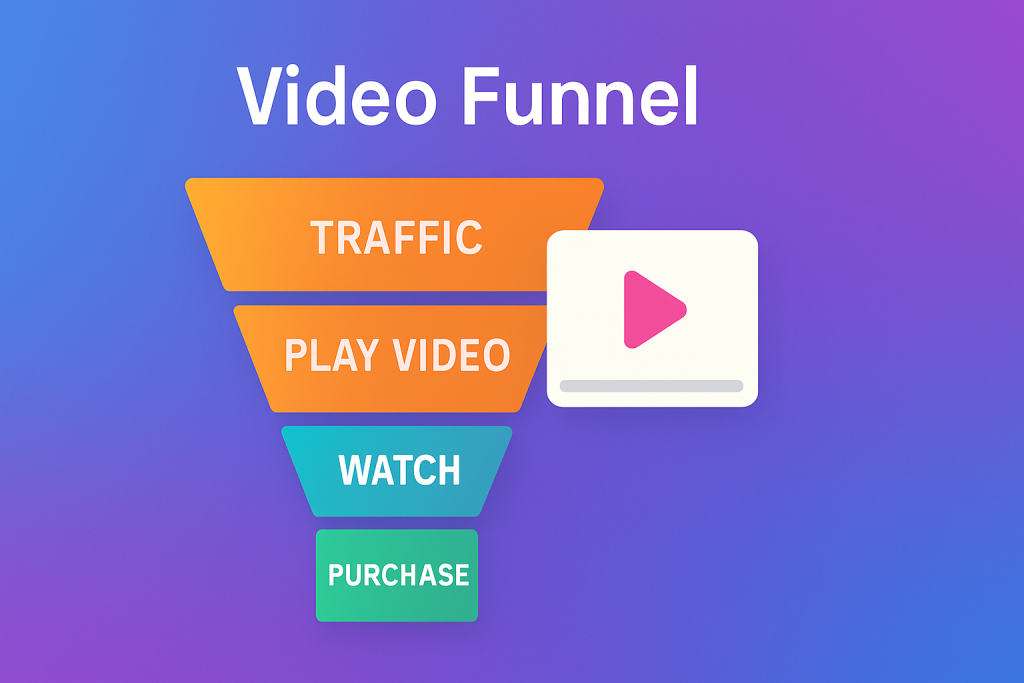
Instead of relying on text-heavy landing pages, this funnel uses a Video Sales Letter (VSL) to build trust and sell — especially for digital courses, coaching, or info products.
🔹 Example:
You’re selling a $499 course on personal branding.
- Landing Page: Has a video that walks through your story, pain points, proof, and the offer.
- CTA Button: Appears after 10+ minutes (scarcity or urgency adds pressure).
- Order Page: Leads to checkout with testimonials, bonuses, and FAQs.
- Follow-Up: Email reminder for people who didn’t finish watching.
🔹 Why it’s useful:
- Mimics a real pitch — more emotional and persuasive.
- Keeps users focused longer than a regular sales page.
4. High-Ticket Funnel (Application Funnel)
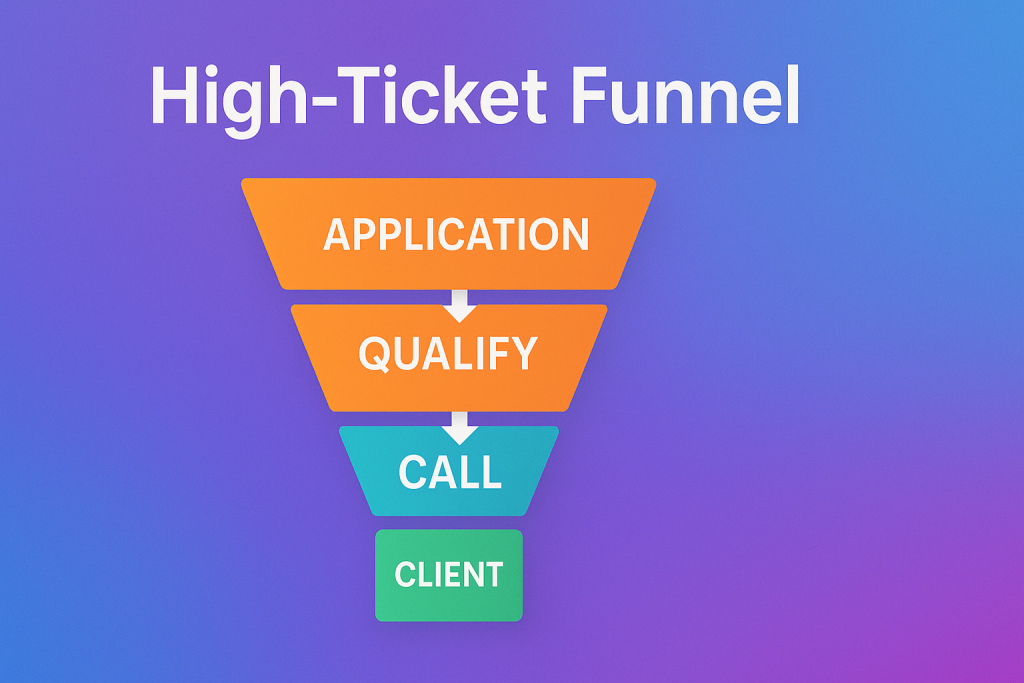
Used for offers priced at $1,000+, this funnel qualifies leads and gets them to book a discovery or strategy call. It’s often used by consultants, agencies, and high-end service providers.
🔹 Example:
You offer 1-on-1 coaching at $5,000.
- Landing Page: “Ready to grow your business to $20K/month?”
- Mini VSL or Written Sales Page: Outlines the method and client results.
- Application Form: Gathers info like goals, income level, struggles, and budget.
- Calendar Booking: Only qualified leads can book a call.
- Sales Call: You close them live or via Zoom.
🔹 Why it’s useful:
- Filters out unqualified leads.
- Allows personal sales for expensive offers.
- High conversion rate (when pre-qualified).
✅ Summary Table
| Funnel Type | Purpose | Ideal For |
|---|---|---|
| Chatbot Funnel | Automate engagement via chat | Local businesses, mobile-heavy sites |
| Quiz Funnel | Segment leads with interactive content | Ecommerce, coaching, SaaS |
| Video Sales Funnel | Convert using persuasive videos | Courses, info products, coaches |
| High-Ticket Funnel | Qualify leads before sales call | Consultants, agencies, high-ticket |
Pro Tip:
These advanced funnels often combine multiple techniques (e.g., a quiz → VSL → application) to create hybrid strategies that feel personal, interactive, and high-converting.
That’s a Wrap on Funnel Types!
You now have a complete view of all major funnel types - from foundational to specialized, analytical, platform-specific, growth, and modern. Whether you're launching a startup, scaling an agency, or selling products online, understanding these funnel types gives you a serious edge.
Best Funnel Builder Platforms
Now that you know all the funnel types, the next step is choosing the right tool to build them. Funnel builders help you design, launch, and track your customer journeys without needing a developer — and many include templates, A/B testing, analytics, and integrations.
Here are 4 top funnel builder platforms you can count on (plus one spot for your pick):
1. ClickFunnels
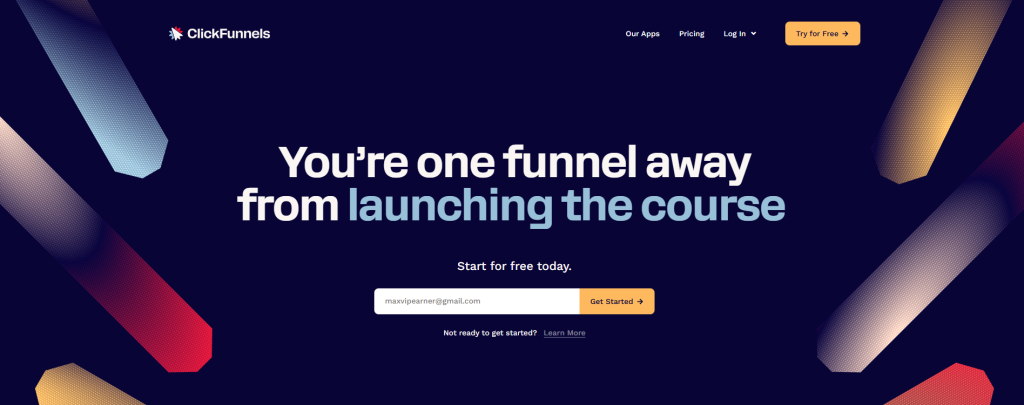
ClickFunnels is one of the most popular funnel builders on the market, especially for entrepreneurs, course creators, and digital marketers.
🔹 Best For:
High-converting sales funnels, webinars, digital products, high-ticket offers
✅ Pros:
- Pre-built funnel templates
- Drag-and-drop builder (no coding)
- Built-in checkout, email marketing, and upsells
- Active community and lots of tutorials
❌ Cons:
- On the expensive side ($97+/month)
- Somewhat dated design flexibility
- Can feel "locked in" to their ecosystem
2. Kartra
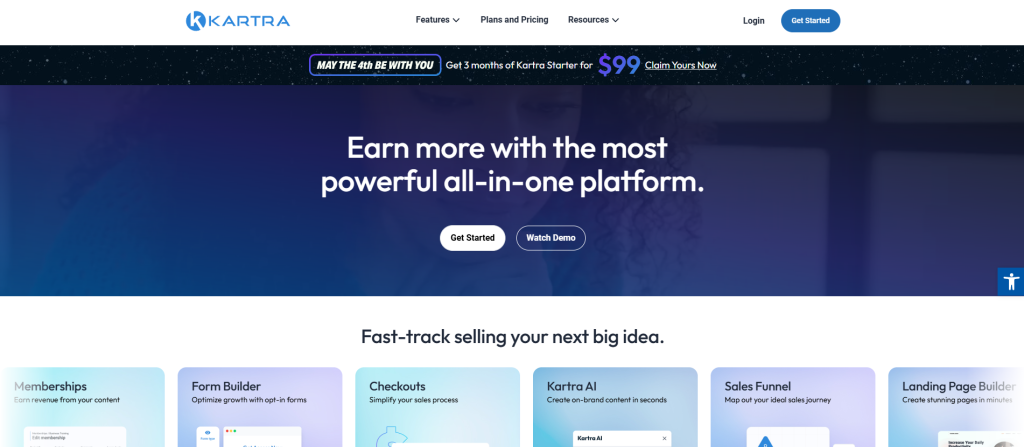
Kartra is an all-in-one funnel and business platform designed to replace multiple tools: landing pages, email automation, membership sites, and more.
🔹 Best For:
Coaches, consultants, info product sellers who want everything in one place
✅ Pros:
- Includes video hosting, memberships, CRM, checkout, helpdesk
- Automation built into everything (smart behavior triggers)
- No need for 3rd-party integrations
❌ Cons:
- Learning curve is steeper
- Slower page load speeds than some competitors
- UI can feel cluttered at times
3. Systeme.io

Systeme.io is a budget-friendly funnel builder that still manages to pack in serious value, especially for beginners or small business owners.
🔹 Best For:
Startups, solopreneurs, course creators on a budget
✅ Pros:
- Free plan (and generous limits)
- Includes funnels, emails, memberships, affiliate management
- Simple and fast to get started
❌ Cons:
- Less design flexibility
- Limited integrations compared to advanced tools
- May not scale well for large, complex setups
4. Webflow + Memberstack (or Zapier, Make)
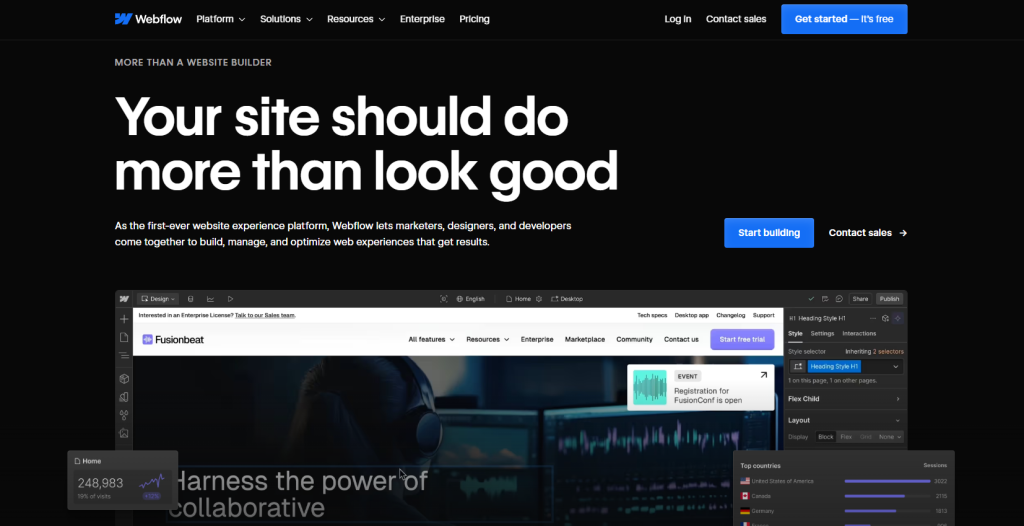
If you want complete design control without writing code — and are willing to connect tools together — this combo gives you power and flexibility.
🔹 Best For:
SaaS, tech startups, advanced marketers who want a unique brand experience
✅ Pros:
- Fully customizable design
- Clean, modern UI
- Integrates with Stripe, Airtable, Zapier, and other tools
- Can scale to complex systems
❌ Cons:
- Requires setup + tool stacking
- No native "funnel builder" logic — must build flows manually
- Steeper learning curve
Estage Funnels: The All-in-One Funnel Framework
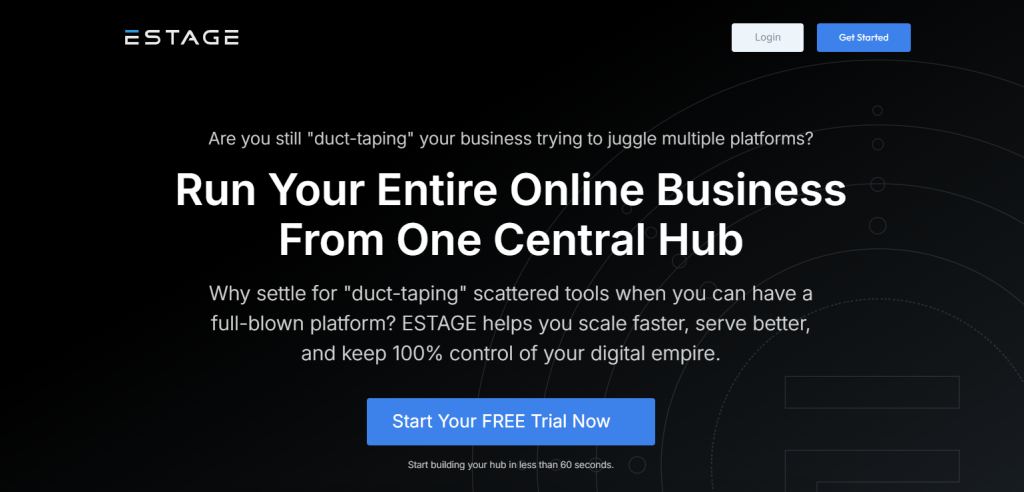
While most businesses use different platforms to build each type of funnel—marketing, sales, onboarding, webinars, etc. Estage Funnels brings everything into one ecosystem. Think of it not just as a builder, but a central command hub that lets you create, connect, and optimize every stage of your funnel under one roof.
Why Estage Funnels Stand Out
- 🔄 Unified Funnel + CRM Integration
Every funnel you build automatically links to your contacts, tagging system, and automation sequences. No need to integrate third-party CRM tools. - 🧩 Modular, Drag-and-Drop Builder
Use Estage’s block-based visual editor to assemble funnels visually—landing pages, checkout steps, upsells, lead magnets, and more. - 📊 Built-In Analytics and A/B Testing
Track performance, user paths, and split-test pages right inside your dashboard without needing external tools like GA4 or VWO. - ⚙️ Funnels for Every Use-Case
Whether you’re launching a course, running a webinar, selling a digital product, or onboarding users, Estage offers pre-designed funnel templates to speed things up. - 📥 Native Checkout and Payment Processing
Sell products, subscriptions, trials, or one-time offers using built-in payment tools—no Shopify, no Stripe plugins, no Zapier. - 📱 Responsive + Fast
Estage Funnels are mobile-optimized and lightning fast, helping improve conversions and reduce drop-off.
Funnel Types You Can Launch with Estage
- Lead Generation Funnels
- Webinar Funnels
- Sales Funnels with Upsells & Downsells
- Email Automation Funnels
- Digital Product Launch Funnels
- Affiliate + Partner Funnels
- Customer Success & Loyalty Funnels
✅ Why It Matters:
With Estage, you don’t have to glue together 5 different apps. Every funnel works seamlessly with your pages, CRM, email automation, analytics, and customer database—giving you an edge in speed, efficiency, and results.
Conclusion: Which Funnel Is Right for You?
Funnels aren’t just a marketing buzzword — they’re one of the most reliable, repeatable frameworks for turning traffic into revenue, strangers into customers, and leads into loyal fans. From classic sales funnels to advanced quiz or chatbot flows, each type serves a specific purpose depending on your product, platform, and audience.
Here’s what to keep in mind:
- Start simple. Don’t try to build 10 funnels at once. Choose the one that aligns with your current goal — whether it’s getting more leads, selling a course, onboarding users, or booking high-ticket clients.
- Track everything. Even the most beautifully designed funnel won’t help if you don’t know where people are dropping off.
- Optimize over time. Funnels are not “set it and forget it” systems — they grow more powerful with testing, tweaking, and real-world feedback.
- Use the right tools. Choose a funnel builder that fits your budget, integrates with your stack, and supports your vision.
With the right funnel in place, you’ll do more than just generate clicks or leads — you’ll build a system that scales, a customer journey that converts, and a business that grows with intention.
Now the only question is:
👉 Which funnel will you launch first?

